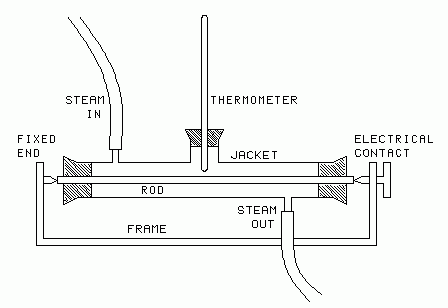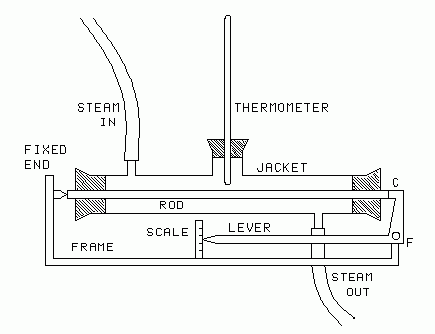H-1 THERMAL EXPANSION OF METALS
To experimentally determine the values of the coefficient of thermal expansion of a metal.
2. APPARATUS
Expansion apparatus consisting of a steam jacket, three corks, and metal rods; water boiler; rubber tubing; bunsen burner; container to catch steam condensation; thermometers. If the micrometer apparatus is used you'll also need a dry cell, wires, and a 3V DC voltmeter.
3. THEORY
When a metal is heated, its linear dimensions increase approximately in proportion to the temperature. Over moderate changes in temperature, the length of a metal sample changes by an amount
| [1] |
ΔL = Lo α (ΔT)
where the Δ (delta) indicates "change in." T is temperature, and L is length. The constant α is called the coefficient of thermal expansion. Lo is the initial length, before expansion.
[The relation is not quite linear. Over large temperature intervals a changes slightly. The temperature change in this experiment is not large enough to show this non-linearity.]
3. PROCEDURE
 |
| Fig 1. Thermal expansion apparatus, electrical form. |
|---|
(1) The metal sample is a rod approximately 60 cm long. Measure its length at room temperature. The rod is held in the steam jacket by insulating corks at each end. One end of the rod touches a fixed screw, while the other end is in contact with a device which measures its change in length. Some versions of the apparatus measure the length changes with a simple mechanical lever system (Fig. 2). Others use a vertical rod and jacket with an optical lever at one end (see experiment PM-1, Young's Modulus, for a discussion of the optical lever).
Most convenient is the version with a simple micrometer screw at one end of the rod, reading to 1/100 mm (Fig. 1). Readings are taken by turning the screw until its point just touches the end of the rod. Contact between the screw and the rod is indicated instantly when it closes an electrical circuit which causes a voltmeter deflection. Your instructor will explain the details of the measuring device.
 |
| Fig 2. Thermal expansion apparatus, lever form. |
|---|
(2) Assemble the apparatus. Connect a rubber hose from the boiler to the steam jacket. Connect another hose to direct the exhaust steam into a beaker or can where it can condense without dripping on the table. Fill the boiler about half full of water. Be sure the boiler cap is screwed on firmly, to prevent unwanted steam escape.
(3) Insert a thermometer in the sidearm cork of the steam jacket.
(4) As the rod expands, do not let it exert force against the micrometer screw. This could bend the entire frame of the instrument. Bring the micrometer screw into contact with the rod only when taking readings, then screw it out again.
(5) To establish the linearity of the expansion, you'll have to take readings of length every few degrees of temperature rise. These temperatures are measured from the thermometer.
(6) The linear expansion coefficient, α, can now be determined from the slope of the graph of ΔL vs. ΔT.
(7) Clean up your lab table. Dry all spills. Return the dry thermometers to the place you got them. Empty the water boiler.
4. QUESTIONS
(1) Suppose the glass in thermometers had the same coefficient of expansion as the liquid in them. Would this affect the readings obtained with the thermometer? If so, how?
(2) Sometimes one observes that when a thermometer is plunged into a hot liquid, the thermometer reading drops for a brief instant before it begins to rise. Why might this happen?
(3) The thermal expansion formula is often written
| [2] |
L = Lo (1 + α ΔT)
Show that this form is correct.
(4) If the micrometer screw were touching the rod when cool, and the experimenter forgot to loosen it while the rod expanded, what is the force the rod would exert on the micrometer screw when steam temperature is reached?
(5) The expansion ΔL was measured to 0.01 mm, or better. Yet the rod length Lo was measured with a meter stick, probably to no better than 0.1 mm. Why is this permissible?
Text and figure © 1996, 2004 by Donald E. Simanek.